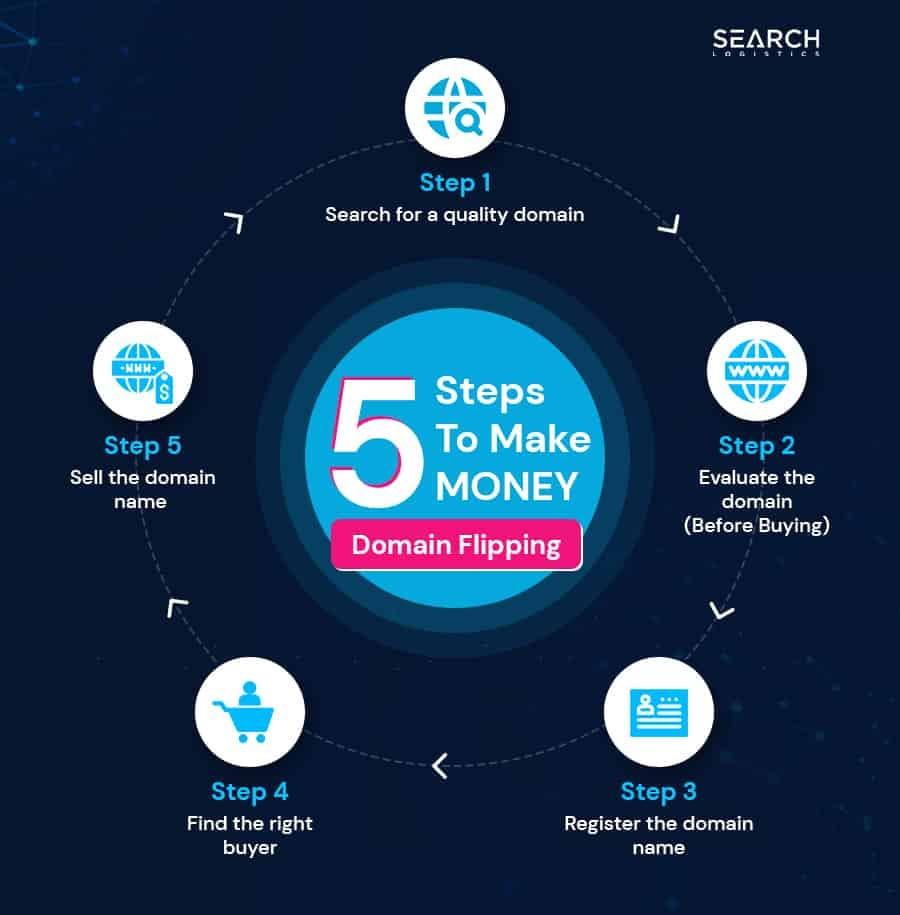Table of Contents
- Understanding the Basics of Domain Flipping
- Identifying High-Value Domain Opportunities
- Strategies for Successful Domain Acquisition
- Maximizing Profit Through Effective Domain Marketing
- Navigating the Challenges of Domain Flipping
- Q&A
- Key Takeaways


Understanding the Basics of Domain Flipping
Imagine stumbling upon a forgotten treasure trove on the internet, with valuable properties that are just waiting to be claimed. This concept is central to the opportunity of domain flipping. At its core, this involves purchasing domain names at a lower price and selling them at a higher value, profiting from the difference. Successful flipping hinges on identifying domains that have potential for monetization or resale—a task requiring both intuition and market insight. This market can be incredibly lucrative due to the digital world’s ever-growing nature, creating a constant demand for memorable, branded online real estate.
- Research: Key to acquiring domains with the highest potential value.
- Creativity: Essential for envisioning future demand or trends.
- Patience: Domains may take time to reach their resale peak.
Flippers often rely on tools and platforms tailored to this niche. Popular websites like Flippa and GoDaddy Auctions provide marketplaces to buy and sell these digital assets with relative ease. Understanding metrics such as traffic estimate, backlink quality, and keyword rankings is crucial. Additionally, branding is important—domains that are short, catchy, and easy to remember tend to sell at higher prices. Here’s a look at some factors influencing domain value:
| Factor | Influence on Value |
|---|---|
| Domain Length | Shorter names are often more valuable. |
| Keywords | Relevant to highly searched topics boost price. |
| TLD (Top Level Domain) | .com domains are generally the most desirable. |
Engaging in this endeavor requires a mix of strategic foresight and market adaptability. Successful flippers not only spot current trends but also anticipate future ones, aiming to catch waves of demand just before they crest. Cultivating relationships with other domain investors and staying informed about domain sales data can provide a competitive edge. Networking not only builds your knowledge base but can also lead to collaborative opportunities, where partnerships may enhance the sale potential of certain domains, creating an enriching and dynamic ecosystem. It’s both an art and a science, where learning from each transaction paves the way for the next profitable adventure.


Identifying High-Value Domain Opportunities
Discovering domains with high potential value requires a mix of strategic research and market insight. Start by assessing keyword popularity and trends associated with a potential domain. High search volumes and low competition are indicators of valuable domain opportunities. Utilize tools like Google’s Keyword Planner or SEMrush to gauge these metrics effectively. Additionally, keep an eye on trending topics or emerging markets. A timely acquisition aligned with a rapidly growing sector could result in a significant payoff.
Consider the length and composition of the domain name itself. Short, memorable, and brandable names often hold the greatest resale potential. Avoid complexity by steering clear of numbers, hyphens, or unusual spellings, as simplicity tends to increase value. When analyzing a domain, think about its commercial viability. Domains with clear intent, such as those revolving around industries like finance, health, or technology, often appeal more to buyers. Create a mental check-list every time you evaluate a domain:
- Is it short and easily remembered?
- Is it brandable and devoid of special characters?
- Does it align with high-demand sectors?
- Could it generate organic search traffic?
To refine your search, leverage online marketplaces and auction platforms for insights into current sales trends. Observing which domains are fetching higher prices can alert you to niche profitability and emerging demand. The table below highlights some popular platforms where domain flipping enthusiasts frequently capitalize on lucrative opportunities:
| Platform | Features | User Base |
|---|---|---|
| Sedo | Wide selection, auction visibility | Global |
| Flippa | Direct sales, robust analytics | Entrepreneurs |
| Aftermarket | Premium listings, easy transfers | Investors |


Strategies for Successful Domain Acquisition
Embarking on the journey of domain flipping demands a strategic mindset to ensure a successful acquisition and eventual resale. Start by researching and identifying niche markets with the potential for growth. A targeted approach often uncovers hidden gems, offering opportunities to secure valuable domains that others may overlook. Utilize tools like Google Trends and SEMrush to analyze market trends, ensuring your acquisitions are not only relevant today but offer long-term potential.
- Due Diligence: Before purchasing a domain, conduct comprehensive due diligence. Check its history to ensure it hasn’t been associated with spam or illegal activities.
- Brandability: Opt for domains that are easy to remember, spell, and pronounce. This increases their appeal for end-users and potential buyers.
- SEO Potential: Look for domain names with keywords that resonate with search engine algorithms.
| Tool | Purpose |
|---|---|
| Google Trends | Analyze market popularity |
| SEMrush | Keyword trend analysis |
| DomainTools | Domain history check |
Once you’ve identified promising domains, negotiation becomes key. Approach sellers with a well-researched offer, using data to justify your proposed price. Consider enlisting the services of a professional domain broker to aid in negotiation, especially when dealing with high-value domains. They bring expertise in closing deals while understanding market dynamics. set clear acquisition goals based on resale potential, timeframes, and market demand, ensuring that your investment aligns with your broader domain flipping objectives.
Maximizing Profit Through Effective Domain Marketing
In the competitive arena of online real estate, domain marketing stands as a pivotal strategy to turn potential web addresses into lucrative assets. To succeed, it’s crucial to understand the subtle art of effective promotion and engagement. First, establish a strong presence on popular domain marketplaces. These platforms not only increase visibility but also attract serious investors scouring for valuable digital properties. In addition, leverage the power of social media by sharing your domains through relevant online communities and groups. Being active in discussions about trends and new opportunities can build a reputation as a credible seller, which is crucial for repeat business.
Maximizing profit in this sphere often involves understanding the characteristics that make a domain name marketable. Key elements include:
- Brandability: Names that are catchy and easy to remember.
- SEO Potential: Domains that include popular keywords relevant to a specific niche.
- Length: Shorter names are generally preferred due to their ease of use and recall.
- Extension: The choice of a domain extension such as .com, .net, or niche-specific TLDs.
Utilizing data analytics and market insights is essential to adapt your strategy for optimal outcomes. Evaluating metrics such as search frequency, advertising potential, and competitive landscape empowers you to make informed decisions. The following table summarizes key metrics to watch:
| Metric | Importance | Action |
|---|---|---|
| Search Volume | High | Target domains with high search demand. |
| Ad Competition | Medium | Analyze to adjust pricing strategies and niche focus. |
| Domain Trends | High | Stay updated to capture emerging markets. |
By understanding these components and utilizing strategic marketing channels, domain flipping can become a consistent revenue stream. This requires patience, insight, and the ability to predict future digital needs.

Navigating the Challenges of Domain Flipping
Achieving success in domain flipping requires overcoming several hurdles that can challenge even seasoned investors. The first step involves smart acquisition, which begins with identifying valuable domain names. These are typically short, memorable, and contain relevant keywords. Using tools like expired domain search engines or domain auction platforms can help you find domains with untapped potential. However, competition on these platforms is fierce. Balancing your budget while acquiring high-quality domains is crucial, as overspending can quickly deplete resources.
Once you’ve acquired a promising domain, evaluating its potential market value is the next hurdle. This demands an understanding of market trends, including popular keywords and industry demand, which can shift rapidly. Tools such as Google Trends or domain appraisers provide insights, but staying flexible and adaptable to new trends is vital. Consider investing in domains that not only have current value but show potential for future demand. This foresight allows you to capitalize on long-term investment strategies.
mastering the art of negotiation is essential to achieving profitable sales. The domain selling landscape often involves complex negotiations with potential buyers, who may be experienced in bargaining. Crafting a compelling sales pitch is essential to showcase the value of your domain. Additionally, creating a listing that highlights the domain’s unique qualities can entice prospective buyers. Consider incorporating elements such as:
- SEO-friendly terms that align with current search engine algorithms.
- Business appeal, including brandability and market desirability.
- Traffic history or potential based on similar successful domains.
Successfully navigating these challenges requires strategic planning and continuous learning. By understanding these key aspects, you can increase your chances of flipping domains with favorable outcomes and minimize the risks involved.

